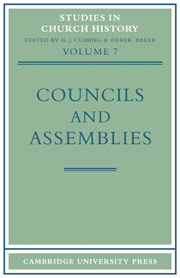Book contents
- Frontmatter
- Preface
- Contents
- Contributors
- Abbreviations
- Public welfare and social legislation in the early medieval councils (Presidential Address)
- National synods, kingship as office, and royal anointing: an early medieval syndrome
- The case of Berengar of Tours
- Ecclesiastica and Regalia: Papal investiture policy from the Council of Guastalla to the First Lateran Council, 1106–23
- Viri religiosi and the York election dispute
- Councils and synods in thirteenth-century Castile and Aragon
- The Byzantine reaction to the Second Council of Lyons, 1274
- The Council of London of 1342
- Education in English ecclesiastical legislation of the later Middle Ages
- The representation of the universitas fidelium in the councils of the conciliar period
- Nicholas Ryssheton and the Council of Pisa, 1409
- The condemnation of John Wyclif at the Council of Constance
- Some aspects of English representation at the Council of Basle
- The Council of Basle and the Second Vatican Council
- The Colloquies between Catholics and Protestants, 1539–41
- King James I's call for an ecumenical council
- John Hales and the Synod of Dort
- Assembly and Association in Dissent, 1689–1831
- The Convocation of 1710: an Anglican attempt at counter-revolution
- Laymen in synod: an aspect of the beginnings of synodical government in South Africa
- The First Vatican Council
- Kikuyu and Edinburgh: the interaction of attitudes to two conferences
The Byzantine reaction to the Second Council of Lyons, 1274
Published online by Cambridge University Press: 12 March 2010
- Frontmatter
- Preface
- Contents
- Contributors
- Abbreviations
- Public welfare and social legislation in the early medieval councils (Presidential Address)
- National synods, kingship as office, and royal anointing: an early medieval syndrome
- The case of Berengar of Tours
- Ecclesiastica and Regalia: Papal investiture policy from the Council of Guastalla to the First Lateran Council, 1106–23
- Viri religiosi and the York election dispute
- Councils and synods in thirteenth-century Castile and Aragon
- The Byzantine reaction to the Second Council of Lyons, 1274
- The Council of London of 1342
- Education in English ecclesiastical legislation of the later Middle Ages
- The representation of the universitas fidelium in the councils of the conciliar period
- Nicholas Ryssheton and the Council of Pisa, 1409
- The condemnation of John Wyclif at the Council of Constance
- Some aspects of English representation at the Council of Basle
- The Council of Basle and the Second Vatican Council
- The Colloquies between Catholics and Protestants, 1539–41
- King James I's call for an ecumenical council
- John Hales and the Synod of Dort
- Assembly and Association in Dissent, 1689–1831
- The Convocation of 1710: an Anglican attempt at counter-revolution
- Laymen in synod: an aspect of the beginnings of synodical government in South Africa
- The First Vatican Council
- Kikuyu and Edinburgh: the interaction of attitudes to two conferences
Summary
On Friday 6 July 1274 the reunion of the Greek and Roman Churches was solemnly proclaimed at the Second Council of Lyons. It was a great occasion, and an occasion of great rejoicing for Pope Gregory X who had convened the assembly. In some ways the Greeks, or the Byzantines, had responded to his invitation rather more satisfactorily than his own people. For of the thirteen crowned heads of western Europe who had been invited to attend only one had found it possible to accept. But the Byzantine Emperor from distant Constantinople had sent his own representative in the person of his Grand Logothete George Akropolites; and with him had come a former Patriarch of Constantinople, Germanos, and the Metropolitan of Nicaea, Theophanes. The Council had opened at Lyons in May 1274. But the Byzantine legates had been delayed by shipwreck on their long journey, and it was not until 24 June that they reached their destination. They were welcomed with the kiss of peace by the Pope and all his cardinals and presented the sealed documents that they had brought with them from the Emperor Michael Palaiologos and from the Byzantine clergy. Five days later, on the Feast of Saints Peter and Paul, the Pope celebrated Mass in the cathedral at Lyons. The Epistle and the Gospel were read in Greek as well as in Latin. Thomas Aquinas had been commissioned, perhaps rather tactlessly, to deliver a speech on the errors of the Greeks.
- Type
- Chapter
- Information
- Councils and Assemblies , pp. 113 - 146Publisher: Cambridge University PressPrint publication year: 1970
- 1
- Cited by



